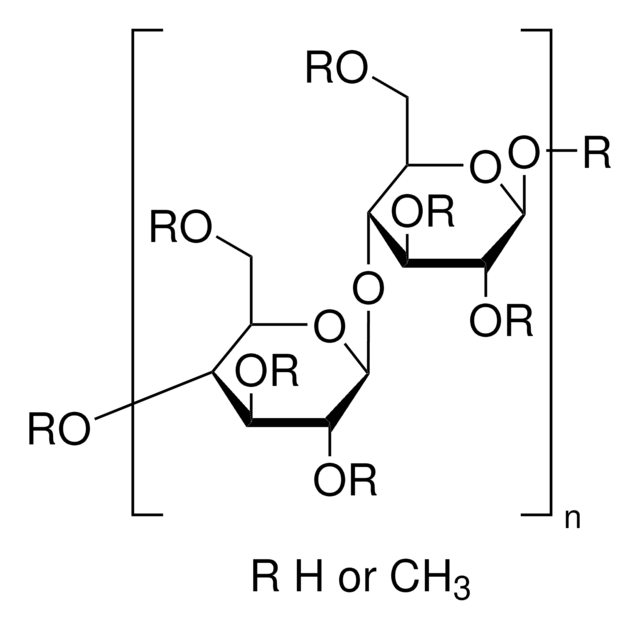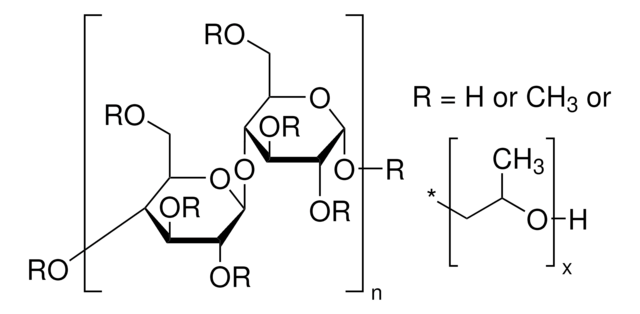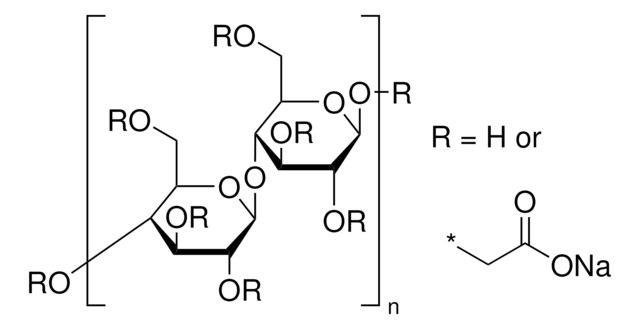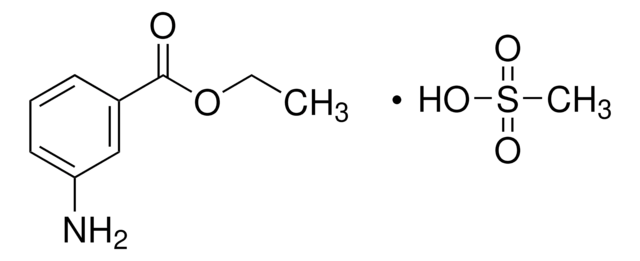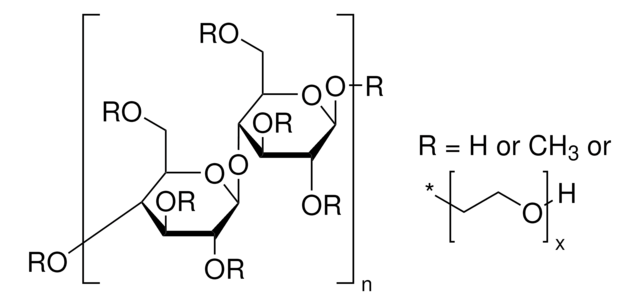All Photos(4)
About This Item
CAS Number:
MDL number:
UNSPSC Code:
12352201
PubChem Substance ID:
NACRES:
NA.25
Recommended Products
biological source
wood (pulp cellulose)
form
powder
color
white to off-white
viscosity
1,200-1,800 cP, 2 % in water(20 °C)
storage temp.
room temp
SMILES string
[*]OC[C@H]1O[C@@H](O[C@@H]2[C@@H](CO[*])O[C@@H](O[*])[C@H](O[*])[C@H]2O[*])[C@H](O[*])[C@@H](O[*])[C@@H]1O[*]
InChI key
YLGXILFCIXHCMC-JHGZEJCSSA-N
Looking for similar products? Visit Product Comparison Guide
General description
Methyl cellulose is a tough, non-toxic material. It is odorless and tasteless. Hence, methyl cellulose is widely used as an adhesive in the food packaging industry. In water-soluble adhesives, it is utilized as a thickening agent. Methyl cellulose is also used as a viscosity control agent. In the cosmetic industry, it is used as an emulsifier, binder and stabilizer.
Application
Methyl cellulose has been used:
- as a component of an embryo medium to culture zebrafish embryos for motility assays
- to mount haploid/tetraploid zebrafish embryos on slides for live imaging
- to enhance the viscosity of artificial seawater to study the flagellar waves of Ciona spermatozoa
Other Notes
To gain a comprehensive understanding of our extensive range of Polysaccharides for your research, we encourage you to visit our Carbohydrates Category page.
Storage Class Code
11 - Combustible Solids
WGK
WGK 1
Flash Point(F)
Not applicable
Flash Point(C)
Not applicable
Personal Protective Equipment
dust mask type N95 (US), Eyeshields, Gloves
Choose from one of the most recent versions:
Already Own This Product?
Find documentation for the products that you have recently purchased in the Document Library.
Customers Also Viewed
Michael Shoujie Sun et al.
PLoS genetics, 15(5), e1008162-e1008162 (2019-05-29)
The first meiotic division reduces genome ploidy. This requires pairing of homologous chromosomes into bivalents that can be bi-oriented within the spindle during prometaphase I. Thereafter, pairing is abolished during late metaphase I, and univalents are segregated apart onto opposite
Ivana Hermanova et al.
The Journal of experimental medicine, 217(6) (2020-03-29)
Gene dosage is a key defining factor to understand cancer pathogenesis and progression, which requires the development of experimental models that aid better deconstruction of the disease. Here, we model an aggressive form of prostate cancer and show the unconventional
The zebrafish mutant lessen: an experimental model for congenital enteric neuropathies
Uyttebroek L, et al.
Neurogastroenterology and Motility, 28(3), 345-357 (2016)
S Mori et al.
Oncogene, 28(31), 2796-2805 (2009-06-02)
The oncogenic phenotype is complex, resulting from the accumulation of multiple somatic mutations that lead to the deregulation of growth regulatory and cell fate controlling activities and pathways. The ability to dissect this complexity, so as to reveal discrete aspects
Handbook of Adhesives and Surface Preparation (2011)
Our team of scientists has experience in all areas of research including Life Science, Material Science, Chemical Synthesis, Chromatography, Analytical and many others.
Contact Technical Service